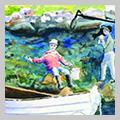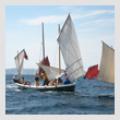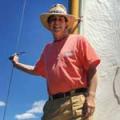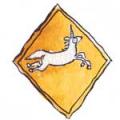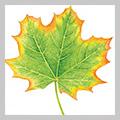Awanadjo Almanack - Issue 103
Issue 103
By Rob McCall
 Illustration by Sam Manning.
Illustration by Sam Manning.
The most beautiful thing we can experience is the mysterious. It is the source of all true art and all science. He…who can no longer pause to wonder and stand rapt in awe is as good as dead. His eyes are closed.
 Illustration by Candice Hutchinson.
Illustration by Candice Hutchinson.
Now that I’m older, hibernation done right can be an extreme luxury. After dinner I’ll sit by the stove and get drowsy over a theology text or a history of the Transcendentalists and a cup of chamomile tea. The book works as fast as the tea—faster, actually. Then, when my eyes start to close I’ll hoist myself up one more time, brush my teeth, give my honey a kiss, and pad up to our huge bed in the cold northeast bedroom from which you can see both the mountain and the bay. One more sip of tea and one more page of Emerson and Alcott with my skull on the pillow and my bones under the quilt, and, brothers and sisters, I’m gone where good bears go.
Bears have it easy. All they have to do is fatten up on free wild blueberries and beechnuts, find a warm den for the winter, and let Nature take her sweet course. We have it a little harder. For one thing, some people are morning people and some are night people. And wouldn’t you know it? They end up marrying each other. For another thing, bears don’t have to go to work or to school all through the long winter. Anyone who has tried to rouse a sleeping teenager for four years of early morning calculus or civics or European history will see the sublime wisdom of starting classes at a saner hour, as many secondary schools now do.
Question: How many promising careers have been nipped in the bud by a naturally somnolent adolescent brain that didn’t start working effectively until 10:00 in the morning, even though the body appeared reasonably operational by 8:00?
Answer: Millions.
Wild speculation
I suspect the experts may one day find ancient evolutionary reasons for all this. Survival once dictated that some stalwart souls stay awake at night to tend the fires and fight off the giant marauding chinchillas to save the peaceful, primal village from destruction.
What’s more, the young have always wanted to do their courting at night. No courting, no babies. No more babies, no more us. See? It makes survival sense.
Students, show this to your parents, who may not yet be too old to remember. And if that doesn’t work, try reading this column in bed. It could help put you to sleep.
Field and forest report, early February
Yes, the bears are slumbering soundly in their dens for the duration, and the chipmunks in the woodpile, and the frogs in the mud of the pond, but on a milder night the skunks may rouse themselves and rustle about in the dark, and the porcupines may rise to greet the dawn with reverence. During the day, cedar waxwings flock to feed on last year’s old apples, rose hips, and viburnum berries. At night the birds retire into the treetops and the thick puckerbrush to hunker down, slumber lightly, and knit up the raveled sleeve of winter care.
Sleep, sleep soundly, one and all.
Sleep-pods to carry to bed with you
From Plato: “How can we determine whether at this moment we are sleeping and all our thoughts are a dream, or whether we are awake, and talking to one another in the waking state?”
And from Leo J. Burke: “People who say they sleep like a baby usually don’t have one.”
Field and forest report, mid February
Flocks of mourning doves arrive daily. They strut with their spouses under the birdfeeder and speed on squeaking wings from tree to tree. We even hear a pileated woodpecker’s love call coming from the old sugar maple behind the town hall on some mornings. A few starlings return, the vanguard of the myriads of black birds we’ll see in a few weeks. Last year at this time someone said at the post office that they’d seen a flock of cardinals in their apple trees. I’m thinking they might have been waxwings, which are fruit eaters, while cardinals are seed eaters. The cedar waxwing does look like the female cardinal, though.
 Illustration by Candice Hutchinson.
Illustration by Candice Hutchinson.
Natural and un-natural events, late February
The Squirrel Wars: Last winter we watched the squirrels around home and town. (We watch them this winter, too, as we do all winters.) For most of the winter one or two red squirrels occupied the pickling pear tree and maintained their fluffy coats and sleek physiques with hearty helpings of sunflower seeds. Town life seemed to agree with them. On a warm day they were active and chased each other around the trunk and the yard. On bitter days, they popped out of a snow burrow, loaded up on seeds, and disappeared.
Then one day a gray squirrel arrived from somewhere and began feeding under the pickling pear, too. We didn’t see the reds and the gray meet face to face, but contrary to local lore, which holds the red to be far more fierce and territorial than the gray and likely to drive it away, both red and gray seemed to be sharing the same territory in full domestic tranquility. This tranquility may be noteworthy, even remarkable, as there are multitudes of “squirrel wars” going on in other places. Google alone lists 139,000 references. How many of us have pushed our ingenuity and patience to the breaking point trying to keep squirrels out of the birdfeeder?
My former brother-in-law was a professional exterminator and hated all squirrels as “bushy-tailed rats.” My own brother, a peaceful man of the cloth, used to go right off the deep end: he would open the back door a crack and fire a pellet rifle at marauding squirrels on the birdfeeder. His family finally took down the feeder to protect the rest of the neighborhood, as he wasn’t the best shot in the world.
Full disclosure: I shot a few squirrels myself when I was in my 20s, for no good reason.
Similar squirrelly passions set off the War of the Red and the Gray back in England last year. Apparently, gray squirrels imported a century ago from the United States were driving the native reds into hiding. Grays numbered 2 million, while reds were down to about 160,000.
Someone was actually counting the squirrels.
Furthermore, the beloved Squirrel Nutkin, a British national hero, was a red, as Beatrix Potter’s lovely drawings demonstrate. Over there in England, squirrel stereotypes are the opposite of ours, with reds cast as gentle and retiring, and grays as thuggish and aggressive.
England’s national lottery granted 626,000 pounds sterling to Save Our Squirrels, an organization that champions the cause of the Redcoats with a hot-line for reports of plundering Grays. More militant still is the Red Squirrel Protection Partnership, which hires exterminators to whack grays with funds provided by the governmental Department for Environment, Food, and Rural Affairs.
As comical as this sounds, still we have to ask, What is going on here?
Field and forest report, late February
Meanwhile the squirrels—red and gray, English and American—go about their ancient business of spreading seeds and nuts far and wide, quietly and relentlessly planting the wild fields and forests of the future to the benefit of every living creature.
Town report, early March
Town meetings get under way around here now that the basketball tournaments are over. On warm days you can hear the cheerful voices of the young going back and forth to school. Last year at this time a jolly group from the consolidated school, led by Mr. Cole and Mr. Schubeck, walked down to the Fish Net for its eagerly awaited annual Spring Grand Opening with free ice cream. Any day now we’ll be hearing the bold and brassy sounds of the George Stevens Academy Band marching joyfully up Main Street with director Steve Orlofsky darting and dancing around them, followed by a line of crawling cars and trucks while the band plays John Phillip Sousa. Boy, it’s great.
Critter of the season
Speaking of the school, the word is they have been investigating crypto-zoology, a fancy name for the study of mythical animals—an ancient human fascination. You’ve probably heard of the Loch Ness monster, the griffin, the unicorn, and the abominable snowman. Well, Maine has its share of these legendary creatures, too.
The great horned water serpent, or wiwilamek of the Penobscot and Passamaquoddy tribes, is one of them. According to folklorist Fannie Hardy Eckstorm, its habitat is the depths of certain large, freshwater lakes in Maine. The beast is 20 to 30 feet long, slimy, and poisonous to the touch. And it is not nice.
A long, epic battle between shaman Old John Neptune and a wiwilamek took place many years ago in Boyden’s Lake far out in wildest Washington County. According to the accounts, the mud and silt stirred up during that confrontation still haven’t settled completely. I won’t tell you who won, but you can find out in Eckstorm’s book Old John Neptune and other Maine Indian Shamans. It’s in the Maine section at the Blue Hill Library.
Mountain report, late March
One day last year at this time, temperatures in the teens, high clouds, and light winds, I started up the Osgood Trail on Awanadjo (“small misty mountain” in Algonkian). Due to the treacherous ice, call it rather the Nogood Trail: paths worn by the passing of many feet become aqueducts; then they freeze. Little streams that run over the trail become wide, sloping mini-glaciers. You get the idea. Ice cleats and a metal-tipped staff are the bywords here.
Despite the ice, parchment-thin beech leaves whispered in the breeze. Tiny green spruce tips littered the corn snow. The great Mother Getchell Birch, with the ancient hunter’s arrow stuck half-way up the trunk, stood stolid as ever. A few more branches were missing perhaps, but it was still ready to seed thousands more saplings for years to come. Runoff trickled under the ancient stone culvert. The view from the St. Francis ledges was breathtaking.
I hadn’t climbed the mountain for too long, and after walking on flat surfaces and sitting in square boxes, the intricate textures of rocks and trees stretched senses and sinews and soothed the soul, shrinking worldly problems back down to their proper size and putting the noisy elements of life back into a natural harmony. This is how the mountain heals.
Near the summit I poked around the charred remains of the burned ranger’s cabin whose windows and roof I used to patch years ago. The old stove was orange with rust, the old enamelware teapot still bright blue in the scorched pile.
On the way down, feeling grateful for the wildness and vowing not to wait so long again, I saw a great raven circling over the south slope on motionless wings. I called out a welcome and was answered with throaty croaks and a couple of barrel rolls as if to say, “Welcome back.”
Seedpods to carry around with you
First, from Christina Baldwin: “Wonder and despair are two sides of a spinning coin. When you open yourself to one, you open yourself to the other: as deeply as you dive, so may you rise.”
Then from Ralph W. Sockman: “The larger the island of knowledge, the longer the shoreline of wonder.”
And from Susan Sontag: “The only interesting answers are those that destroy the questions.”
And finally from E.B. White: “The first day of spring was once the time for taking young virgins into the fields, there in dalliance to set an example in fertility for nature to follow. Now we just set the clocks an hour ahead and change the oil in the crankcase.”
That’s the almanack for this time. But don’t take it from me—I’m no expert. Go out and see for yourself.

Rob McCall is the minister of the First Congregational Church, Blue Hill, Maine. This almanack is excerpted from transcripts of his weekly radio show, which can be heard on WERU, 89.9 FM Blue Hill and 102.9 FM Bangor, and streamed live via www.weru.org. Readers can contact him directly via e-mail: awanadjoalmanack@gmail.com.
 Illustration by Sam Manning.
Illustration by Sam Manning.—Albert Einstein
Dear Friends:
Sleep is natural, especially in the winter. Hibernation is not just for the bears. With the weather forbidding, the ground frozen, and the nights long, what better than to catch up on all that sleep we lost last summer, or last year, or back in our 20s and 30s when sleeping was optional, but partying wasn’t.
 Illustration by Candice Hutchinson.
Illustration by Candice Hutchinson. Illustration by Candice Hutchinson.
Illustration by Candice Hutchinson.Yr. mst. hmble & obd’nt servant,
Rob McCall

Rob McCall is the minister of the First Congregational Church, Blue Hill, Maine. This almanack is excerpted from transcripts of his weekly radio show, which can be heard on WERU, 89.9 FM Blue Hill and 102.9 FM Bangor, and streamed live via www.weru.org. Readers can contact him directly via e-mail: awanadjoalmanack@gmail.com.
Related Articles
Share this article:
2023 Maine Boat & Home Show

Join Us for the Maine Boat & Home Show!
Art, Artisans, Food, Fun & Boats, Boats, Boats
August 11 - 13, 2023 | On the waterfront, Rockland, Maine
Click here to pre-order your tickets.
Show is produced by Maine Boats, Homes & Harbors magazine.







